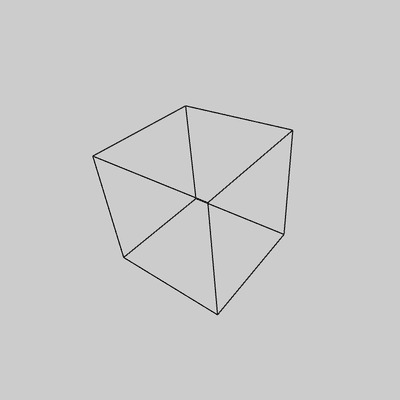Processing, camera()用法介紹。
用法
camera()camera(eyeX, eyeY, eyeZ, centerX, centerY, centerZ, upX, upY, upZ)
參數
eyeX(float)眼睛的 x 坐標eyeY(float)眼睛的 y 坐標eyeZ(float)眼睛的 z 坐標centerX(float)場景中心的 x 坐標centerY(float)場景中心的 y 坐標centerZ(float)場景中心的 z 坐標upX(float)通常為 0.0、1.0 或 -1.0upY(float)通常為 0.0、1.0 或 -1.0upZ(float)通常為 0.0、1.0 或 -1.0
返回
void
說明
通過設置眼睛位置、場景中心以及哪個軸朝上來設置相機的位置。移動眼睛的位置和它指向的方向(場景的中心)可以從不同的角度看到圖像。沒有任何參數的版本將相機設置為默認位置,指向顯示窗口的中心,Y軸向上。默認值為camera(width/2.0, height/2.0, (height/2.0) / tan(PI*30.0 /
180.0), width/2.0, height/2.0, 0, 0, 1, 0).這個函數類似於gluLookAt()在 OpenGL 中,但它首先清除當前的相機設置。
例子
size(400, 400, P3D);
noFill();
background(204);
camera(70.0, 35.0, 120.0, 50.0, 50.0, 0.0,
0.0, 1.0, 0.0);
translate(50, 50, 0);
rotateX(-PI/6);
rotateY(PI/3);
box(45);
相關用法
- Processing case用法及代碼示例
- Processing catch用法及代碼示例
- Processing captureEvent()用法及代碼示例
- Processing clip()用法及代碼示例
- Processing curveDetail()用法及代碼示例
- Processing char()用法及代碼示例
- Processing ceil()用法及代碼示例
- Processing curveVertex()用法及代碼示例
- Processing concat()用法及代碼示例
- Processing continue用法及代碼示例
- Processing color()用法及代碼示例
- Processing copy()用法及代碼示例
- Processing createFont()用法及代碼示例
- Processing cos()用法及代碼示例
- Processing circle()用法及代碼示例
- Processing char用法及代碼示例
- Processing color用法及代碼示例
- Processing createImage()用法及代碼示例
- Processing createShape()用法及代碼示例
- Processing class用法及代碼示例
- Processing curve()用法及代碼示例
- Processing curveTightness()用法及代碼示例
- Processing createInput()用法及代碼示例
- Processing constrain()用法及代碼示例
- Processing clear()用法及代碼示例
注:本文由純淨天空篩選整理自processing.org大神的英文原創作品 camera()。非經特殊聲明,原始代碼版權歸原作者所有,本譯文未經允許或授權,請勿轉載或複製。
